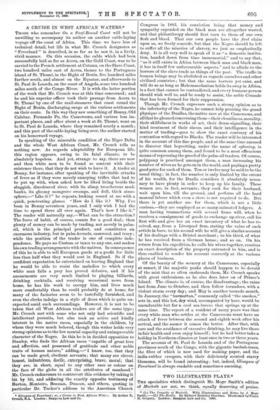TWO ILLUSTRATED PLAYS.* THE specialties which distinguish Mr. Nor Smith's
edition of Macbeth are not, we think, equally deserving of praise.
• ("1„) The Tragedie of Macbeth. With Illustrations and Notes by J. Moyr Smith.—(2.) The Rivals. By Richard Brinsley Sheridan. Illustrated by Prank M. Gregory. London : Sampson Low and Co. 1889.
He begins, to take them in the order suggested by his preface, by reverting to the First Folio of 1623 for his text. For this, he says, the folio is the sole authority,—and, he might have added, as little of an authority as any editio princeps could well be. Its value as a curiosity is great ; a fac-simile of it is undoubtedly interesting. But it cannot be argued with any probability that it represents accurately what Shakespeare wrote. It appeared seven years after his death, and we know nothing with certainty about the manuscript from which it was printed,—though what we may reasonably conjecture about this manuscript certainly makes us think that it may have been very much corrupted. If Mr. Moyr Smith means, as he seems to mean, that Shakespeare's plays for common tise should be printed as he has chosen to print Macbeth, we wholly differ from him. A somewhat parallel case may be found in the first editions of some of Milton's poems. An exact repro- duction of the Samson Agonistes as it appeared in 1671 would be grotesque. It is obvious that the proofs have never been corrected. What was brought about in the Samson by the poet's blindness was brought about in the folio of 1623 by the fact that Shakespeare was no longer alive when it appeared ; and it would seem that while be was alive he had been singularly careless about his writings. It seems pedantry, except as a curiosity, to print "scorched the snake," instead of the obvious " scotch ed " 2), or" mallice," or" then" instead of "than," in :— "Better be with the dead, Whom we, to gaine our peace, have sent to peace, Than on the torture of the mind to lye In restlesse extasie."
" Place " for " peace " is a tolerably clear correction of an in- stance of dittography. For the next specialty, the illustration of the drama by reproductions of costume, armour, and furniture, we have nothing but praise. This gives a more than common value to the illustrations, though a captions critic might argue that an editor who was anxious to give us nothing but Shakespeare would have repudiated details to which Shakespeare was certainly indifferent. We shall not, however, quarrel with Mr. Moyr Smith for his painstaking antiquarianism. Where this feature comes in, the illustrations are uniformly excellent. Their artistic value we can hardly rate so highly. Most readers, we fancy, will prefer, for in- stance, in Plate 23, the elaborate picturing of "the carved door with the circular panels" to the figures of the King and
the "cream-faced bone." Some of the designs, however, show a certain power of imagination ; and Plate 7. "Lady Macbeth Reading the Letter," is a graceful drawing which has perhaps caught something from Miss Terry's impersona-
tion of the character. The general appearance of the volume may be commended in the highest terms.
Nothing by way of editing has been done for The Rivals. We have Sheridan's preface ; the original cast,as the play was acted at Covent Garden for the first time in 1775; the first Prologue, and that which was spoken on the tenth night ; the Epilogue ; and then the play, "without note or comment." The illustrations are forty-three in number,—five " aquarelles." and the remainder in black and white. The aquarelles seem to us particularly good, the frontispiece, "Bob Acres," being perhaps the best. We are inclined to think that the figure of Lydia Languish is too mature in the second. She is younger in the fifth "black and white," and younger still in the twenty-eighth. The drawings in black and white, if less uniform in value, have, for the most part, much merit. The head of "Fag," on p. 14, is excellent. So is "Falkland and Julia," while "Captain Absolute and Mrs. Malaprop," oppo- site to p. 26, is far less successful. But author and publisher between them have produced a very attractive edition of The Rivals.



















































 Previous page
Previous page